New Insight into Organic Metal Polyaniline Morphology and Structure
Abstract
:1. Introduction
2. Results and Discussion
2.1. Polyaniline-Metal complexes

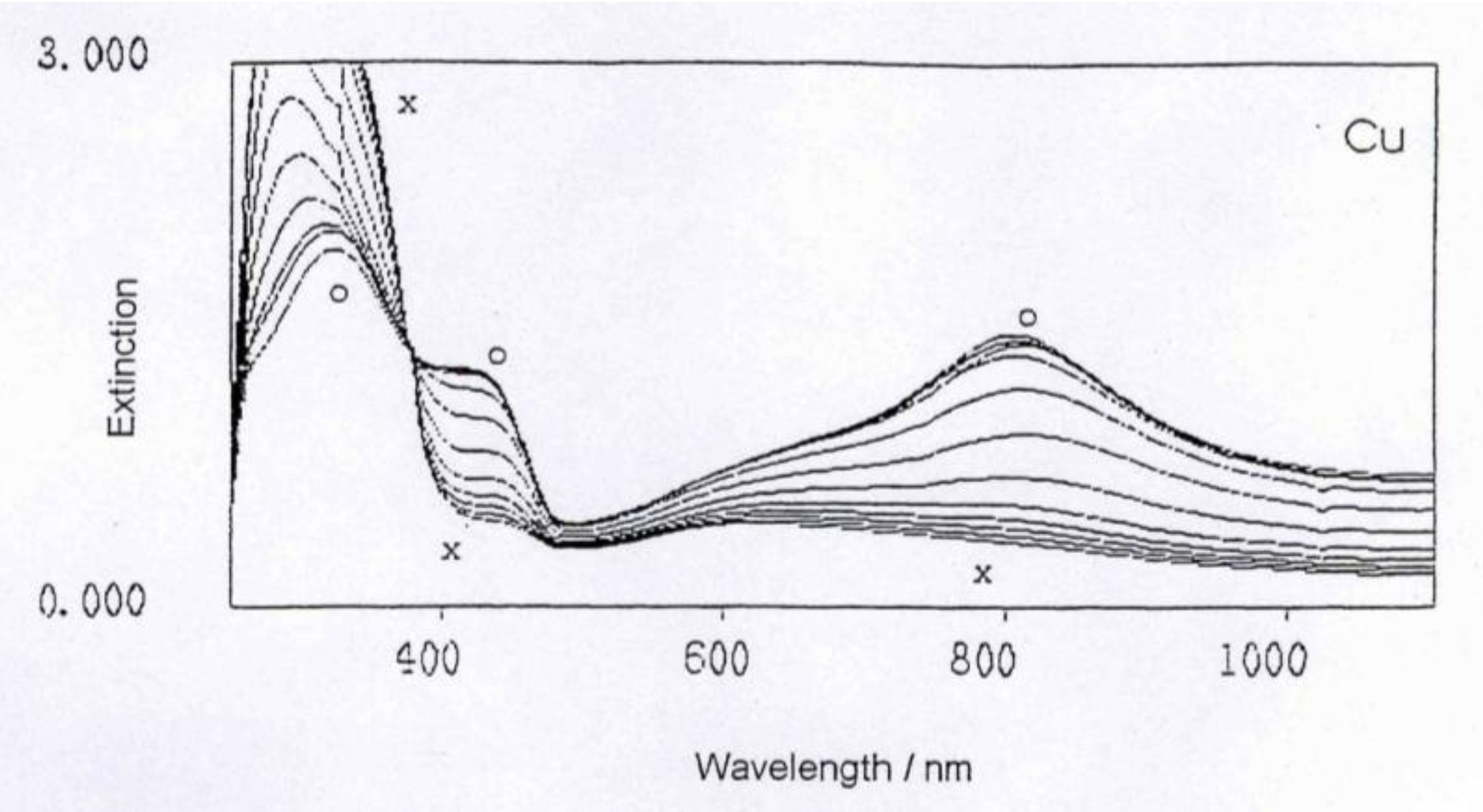
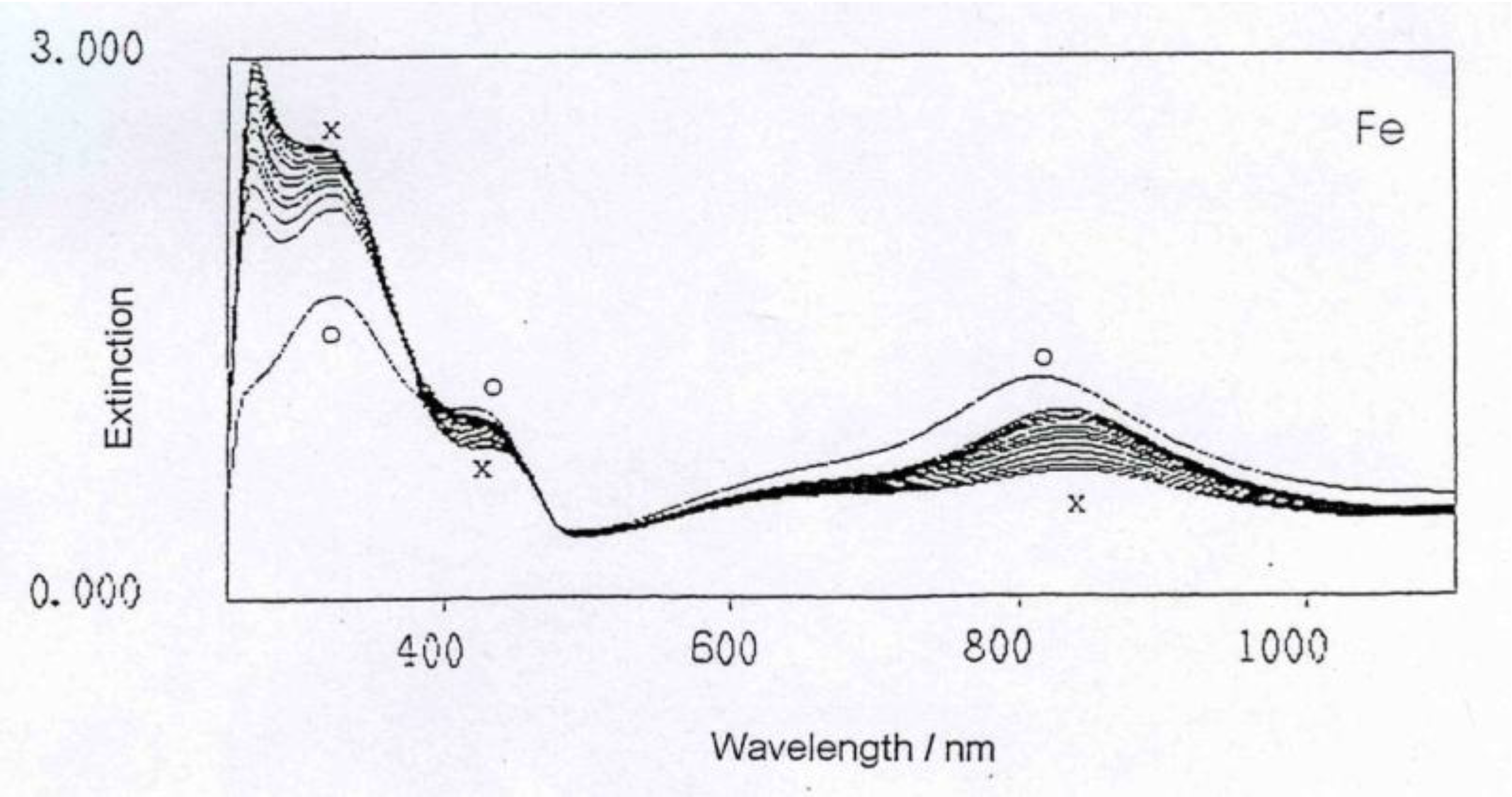
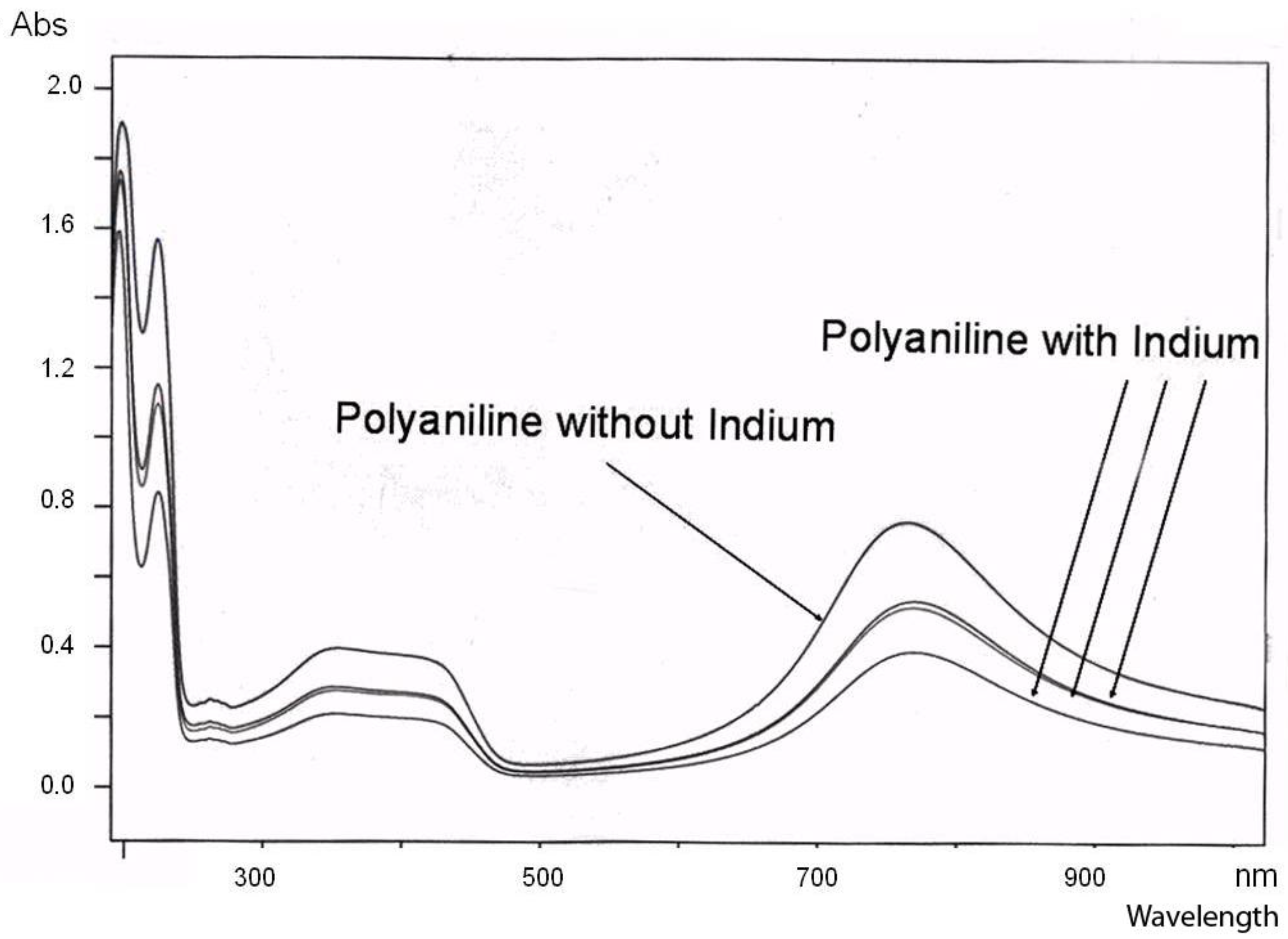
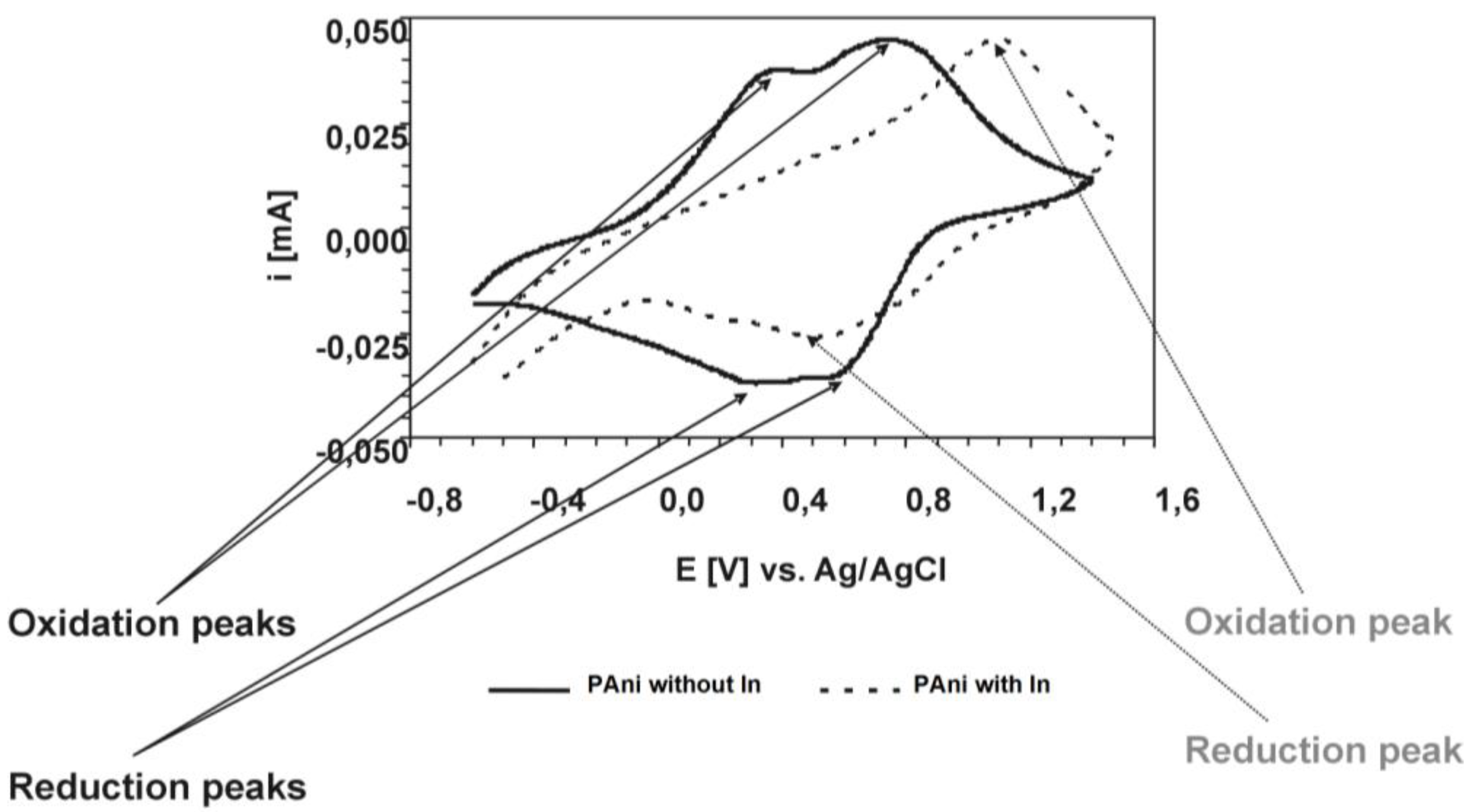
2.2. X-Ray Diffraction Studies
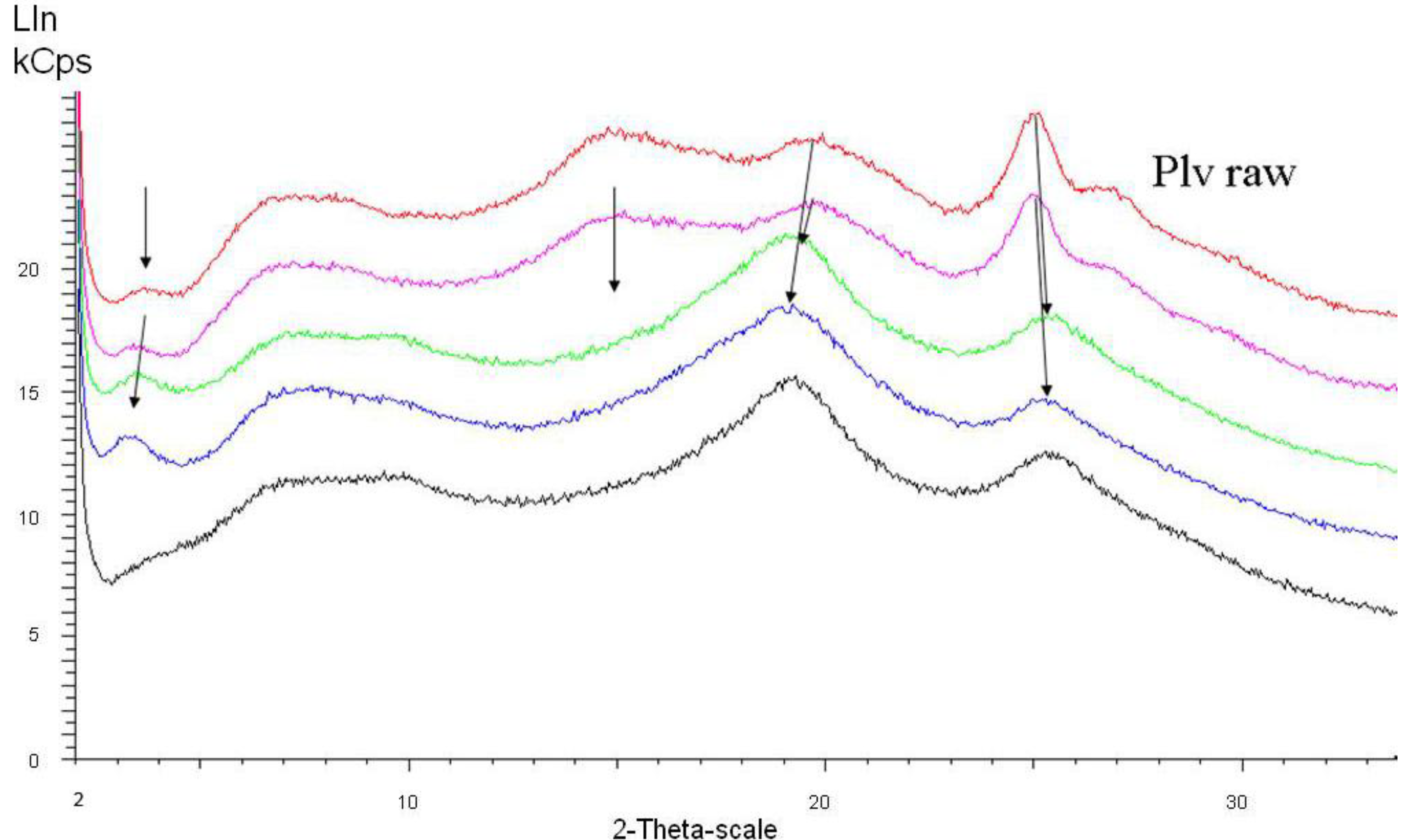
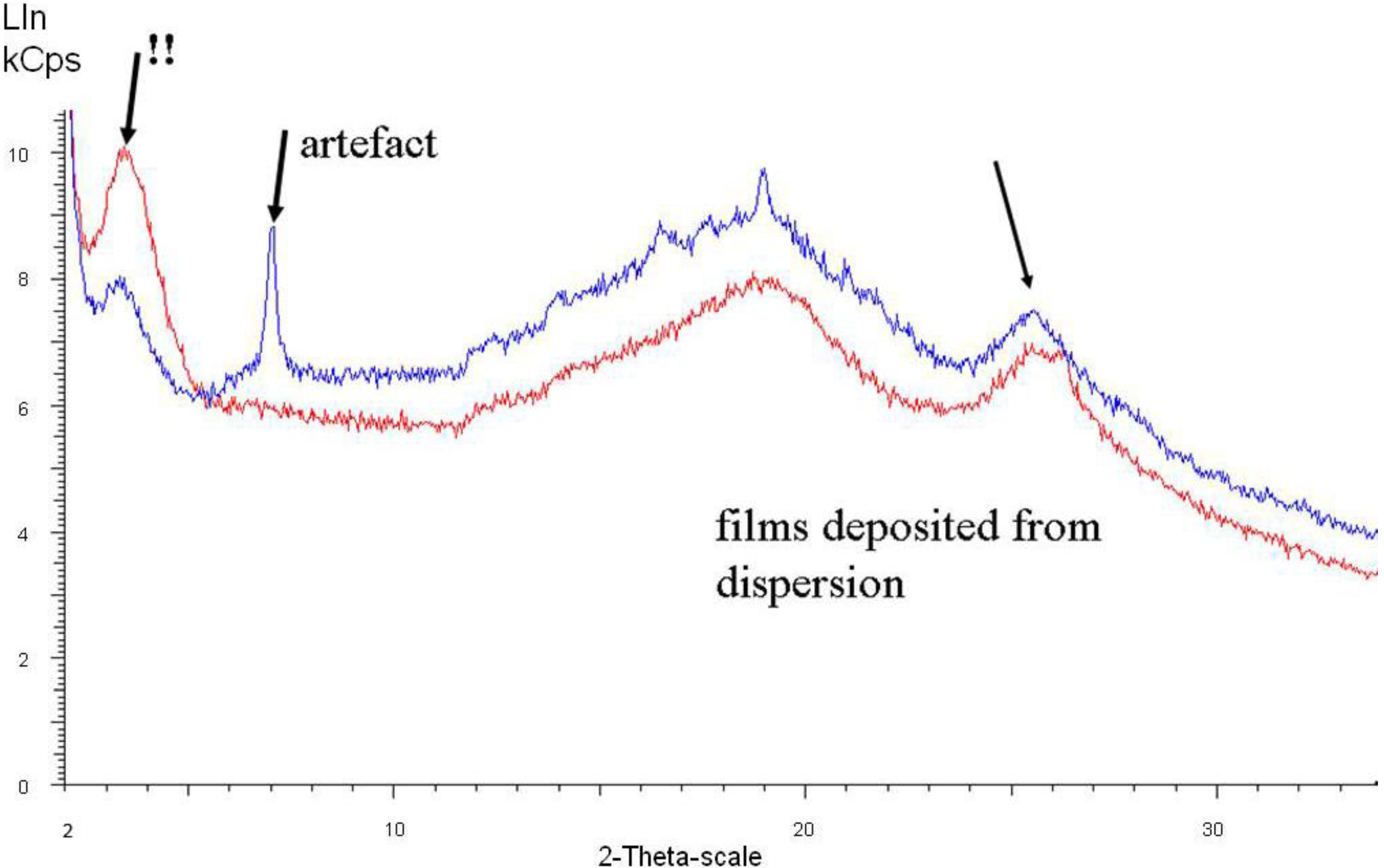
2.3. A New Structure Model for the Organic Metal Polyaniline
| Peak at 2θ (and distance in Å) | Interpretation | ||
|---|---|---|---|
| 27° | vanishing, merging | Ar↔Ar (different distance) | |
| 25° | 3.6 | merging with 27° | Ar↔Ar (finally only one distance range) |
| 20°➔19° | 4.4➔4.7 | shifting | density fractions homogenized, more fractions with 1.6 and 1.8 g/cm³ |
| 15° | vanishing | ||
| 7–10° | 9–15 | broad | thickness of polyaniline chain including dopant |
| 4°➔3.5° | 22➔25 | helix turn distance | |
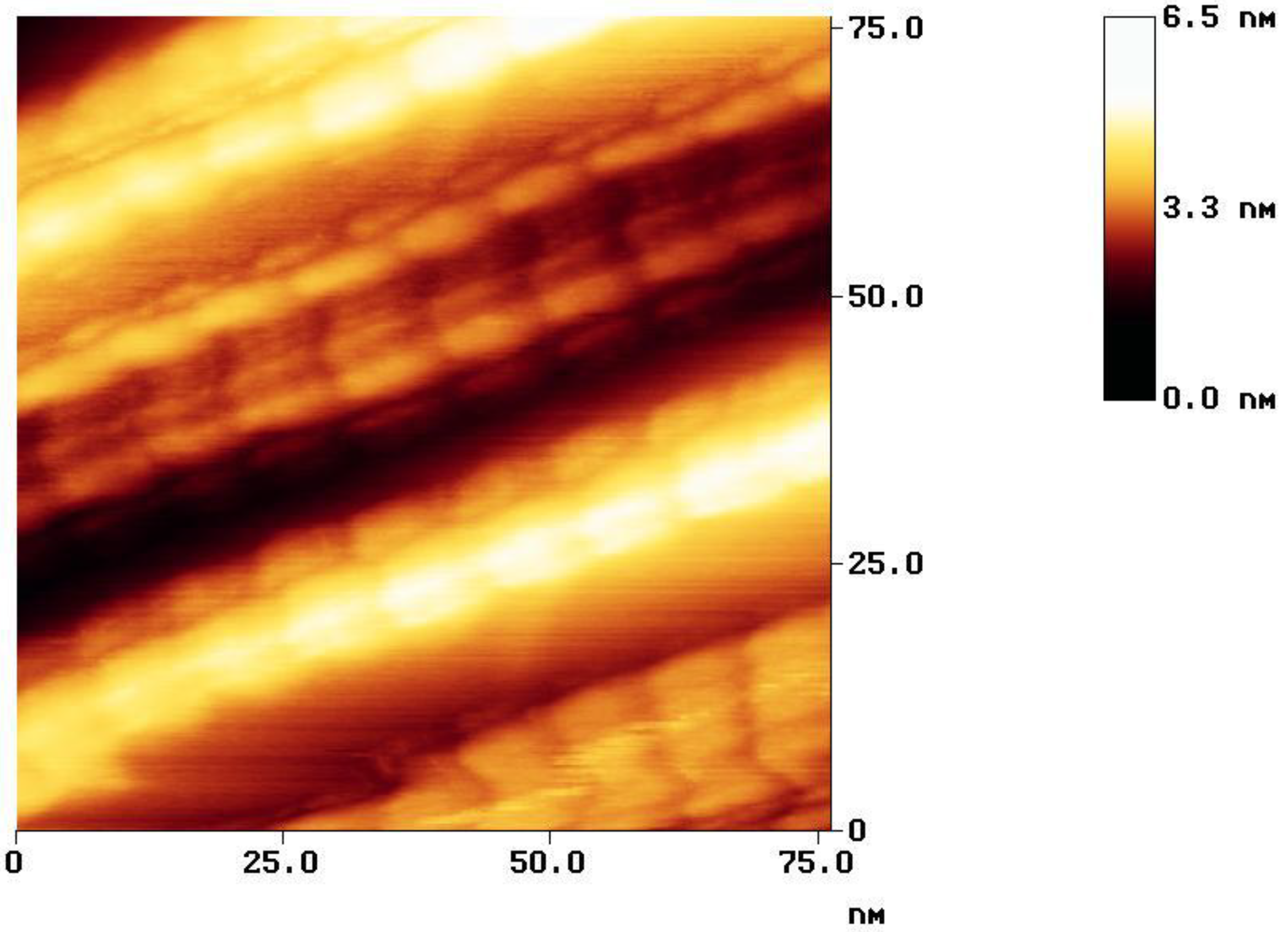
- -
- primary particle size of around 10 nm (globular form) before dispersion
- -
- after completed dispersion, the form is ellipsoidal with a dimension of 13 (long diameter) and 6 nm (short diameter)
- -
- the primary particle contains a certain number of polyaniline molecules which attain an average diameter of roughly 3.5 nm
- -
- the chain thickness (including dopants) is about 1.2 nm
- -
- the chain is coiled forming a (short) helix
- -
- before dispersion takes place, the short helical polyaniline chains are almost randomly oriented within the mainly globular primary particle
- -
- -
- the arrangement of the short helices after dispersion is (in optimal or ideal case) such that effectively a longer helix is formed (see Figure 10)
- -
- it is tempting to hypothesize that in the case of the Cu complex, one helix can complex one Cu ion, and in case of the Fe (and other Me2+ complexes) two helices would complex one ion
- -
- we do not know where the dopants are located—inside the helix, “on top”, or “at the bottom” of the helical chain? (“top” and “bottom” referring to the helix direction)
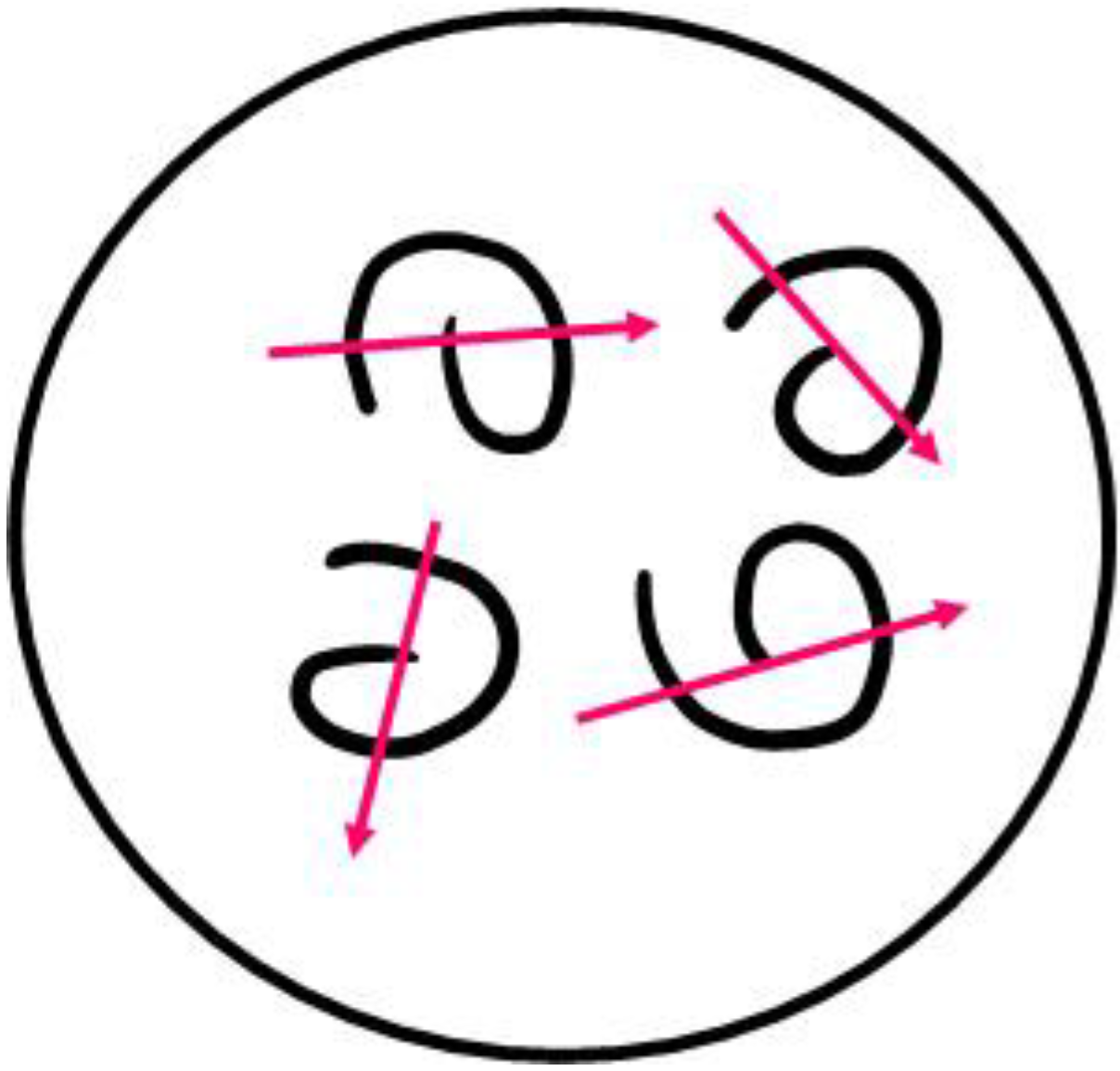
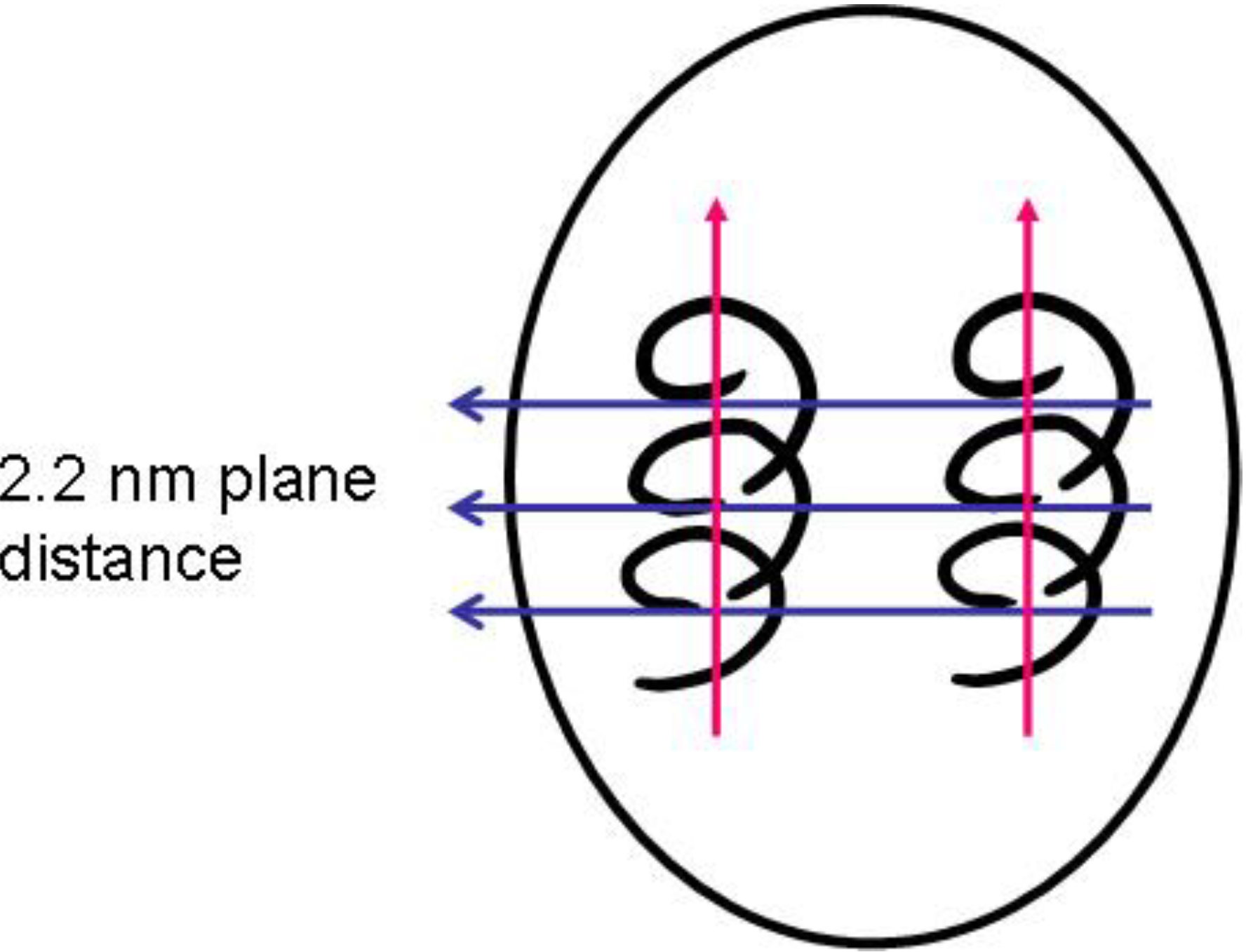
3. Experimental Section
4. Conclusions
Acknowledgements
References and Notes
- Wessling, B. Conductive Polymers as Organic Nanometals. In Handbook of Nanostructured Materials and Nanotechnology; Nalwa, H.S., Ed.; Academic Press: New York, NY, USA, 2000; Volume 5, pp. 501–575. [Google Scholar]
- Wessling, B. Dispersion as the Key to Processing Conductive Polymers. In Handbook of Conducting Polymers, 2nd ed.; Skotheim, T., Elsenbaumer, R., Reynolds, J., Eds.; Marcel Dekker, Inc.: New York, NY, USA, 1998; pp. 467–530. [Google Scholar]
- Wessling, B. Dispersion Hypothesis and Non-Equilibrium Thermodynamics: Key Elements for a Materials Science of Conductive Polymers. Synth. Met. 1991, 45, 119–149. [Google Scholar] [CrossRef]
- Wessling, B. Critical Shear Rate-the Instability Reason for the Creation of Dissipative Structures in Polymers. Z. Phys. Chem. 1995, 191, 119–135. [Google Scholar] [CrossRef]
- Srinivasan, D.; Rangarajan, G.; Mietzner, T.; Lennartz, W.; Wessling, B. Dispersion Induced Insulator-to-Metal Transition in Polyaniline. Eur. Phys. J. 2000, E2, 207–210. [Google Scholar]
- Wang, Z.; Li, C.; Scher, E.; MacDiarmid, A.; Epstein, A. The Granular Metal Concept for Polyaniline. Phys. Rev. Lett. 1991, 66, 1745–1748. [Google Scholar] [CrossRef] [PubMed]
- Marquardt, P.; Nimtz, G.; Mühlschlegel, P. On the Quasi-Static Conductivity of Sub-Micrometer Crystals. Solid State Commun. 1988, 65, 539–542. [Google Scholar] [CrossRef]
- Nimtz, G.; Marquardt, P.; Gleiter, H. Size-Induced Metal-Insulator Transition in Metals and Semiconductors. J. Cryst. Growth 1986, 86, 66. [Google Scholar] [CrossRef]
- Nimtz, G.; Enders, A.; Marquardt, P.; Pelster, R.; Wessling, B. Size-Limited Conductivity in Sub-Micrometre Metal Particles. Similarities with Conducting Polymers? Synth. Met. 1991, 45, 197–201. [Google Scholar] [CrossRef]
- Pelster, R.; Nimtz, G.; Wessling, B. Fully Protonated Polyaniline: Hopping Transport on a Mesoscopic Scale. Phys. Rev. B 1994, 49, 12718–12723. [Google Scholar] [CrossRef]
- Nimtz, G.; Stahlhofen, A. Universal Tunneling Time for All Fields. Ann. Phys. (Berlin) 2008, 17, 374–379. [Google Scholar] [CrossRef]
- Wessling, B. Dispersion—The Key Tool for Understanding, Improving and Using Conductive Polymers and Organic Metals. Synth. Met. 2005, 1-3, 5–8. [Google Scholar] [CrossRef]
- Krinichnyi, V.I.; Roth, H.; Schrödner, M.; Wessling, B. EPR Study of Polyaniline Highly Doped by p-Toluenesulfonic Acid. Polymer 2006, 47, 7460–7468. [Google Scholar] [CrossRef]
- Epstein, A. Conducting Polymers—Electrical Conductivity. In Physical Properties of Polymers Handbook; Mark, J.E., Ed.; Springer Science and Business Media: New York, NY, USA, 2007; p. 730. [Google Scholar]
- Lennartz, W.; Mietzner, T.; Nimtz, G.; Wessling, B. Morphological Changes in PAni-PMMA Blends during Dispersion Studied by SAXS. Synth. Met. 2001, 119, 425–426. [Google Scholar] [CrossRef]
- Wessling, B. Metal Complexes with Polyaniline and Process for Their Preparation. EP 1 002 322, 24 November 2004. [Google Scholar]
- Wessling, B. Polyaniline Complex with Indium, Process for its Preparation and Use. WO2007/020100, February 2007. [Google Scholar]
- Posdorfer, J; Wessling, B. Passivation and Solderability Prevention of Copper by a Polyaniline/Silver Nanoparticle. Presentation at the International Conference on Science and Technology of Synthetic Metals (ICSM), Porto de Galinhas, Pernambuco, Brazil, August 2008; Available online: http://www.organic-nanometal.de/pdf/technology/recentpublications/OMNanofinish_ICSM2008_final.pdf (accessed on 10 December 2010).
- Wessling, B.; Thun, M.; Arribas-Sanchez, C.; Gleeson, S.; Posdorfer, J.; Rischka, M.; Zeysing, B. An Organic Metal/Silver Nanopoarticle Finish on Copper for Efficient Passivation and Solderability Preservation. Nano Express. 2007. Available online: http://www.springerlink.com/content/63260u84285330l4/fulltext.html (accessed on 10 December 2010). [CrossRef]
- Wessling, B. Ormecon’s Organic Metal Technology—Science and Application. In Presented at the International Conference on Science and Technology of Synthetic Metals (ICSM), Kyoto, Japan, 6 July 2010. paper # 6B2-02. [Green Version]
- Wessling, B. Metallic Properties due to Dispersion. In Handbook of Organic Conductive Molecules and Polymers; Nalwa, H.S., Ed.; John Wiley & Sons: New York, NY, USA, 1997; Volume 3, pp. 497–578. [Google Scholar]
- Wessling, B.; Schröder, S.; Gleeson, S.; Merkle, H.; Schröder, S.; Baron, F. Reaction Scheme for the Passivation of Metals by Polyaniline. Mater. Corros. 1996, 47, 439–445. [Google Scholar] [CrossRef]
- Posdorfer, J.; Ormecon GmbH, Ammersbek, Germany. Personal communication. [Green Version]
- Wessling, B. Multistep Dispersion Process for Increasing Conductivity of Polyaniline. WO2005/070972, DE 20 2005 010 364, 10 October 2008. [Google Scholar] [Green Version]
- Pornputtkul, Y.; Kane-Maguire, L.A.P.; Innis, P.C.; Wallace, G.G. Asymmetric Proliferation with Optically Active Polyanilines. Chem. Commun. 2005, 36, 4539–4541. [Google Scholar] [CrossRef]
- Wessling, B.; Hiesgen, R.; Meissner, D. STM Investigations on Primary Particle Morphology of Polyaniline. Acta Polym. 1993, 44, 132–134. [Google Scholar] [CrossRef]
- Wessling, B. Process for the Polymerisation of Submicron Size Dispersible Particles of Conductive Polymers. EP 0 700 573, 20 November 1996. [Google Scholar] [Green Version]
- Wessling, B. Anisotropic Primary Particles of Conductive Polymers and Process for Their Formation. WO 2006/09/2292, DE 10 2005 010 162, 14 June 2007. [Google Scholar] [Green Version]
- Brown, B.; Avecia Inc., Manchester, UK. Personal communication. [Green Version]
- Chi, L.; University of Muenster, Muenster, Germany. Personal communication. [Green Version]
© 2010 by the authors; licensee MDPI, Basel, Switzerland. This article is an open access article distributed under the terms and conditions of the Creative Commons Attribution license (http://creativecommons.org/licenses/by/3.0/).
Share and Cite
Wessling, B. New Insight into Organic Metal Polyaniline Morphology and Structure. Polymers 2010, 2, 786-798. https://doi.org/10.3390/polym2040786
Wessling B. New Insight into Organic Metal Polyaniline Morphology and Structure. Polymers. 2010; 2(4):786-798. https://doi.org/10.3390/polym2040786
Chicago/Turabian StyleWessling, Bernhard. 2010. "New Insight into Organic Metal Polyaniline Morphology and Structure" Polymers 2, no. 4: 786-798. https://doi.org/10.3390/polym2040786
APA StyleWessling, B. (2010). New Insight into Organic Metal Polyaniline Morphology and Structure. Polymers, 2(4), 786-798. https://doi.org/10.3390/polym2040786




